
Home » Archives for 2013
Friday, December 27, 2013
Automatic Switch For Audio Power Amplifier

Boomer Audio Power Amplifier Using LM4906

Battery Juicer

Build a 60Hz Power Inverter Circuit Diagram
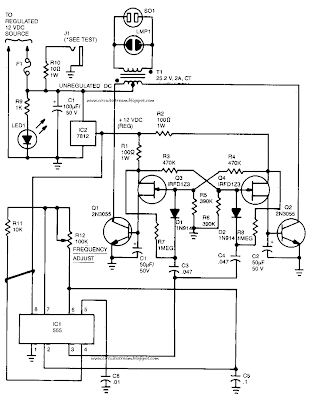
Thursday, December 26, 2013
Single Chip Theremin Circuit Diagram
Single Chip Theremin Circuit Diagram

Simple Active ir Motion Detector Circuit Diagram



1W BTL Audio Amplifier
1 Watt BTL Audio Amplifier Circuit diagram:

The self protection can avoid the happening of over voltage
Domestic mobile Internet into the outbreak, followed by the huge market potential is attracting people of insight. With speeds faster and faster, more powerful mobile terminals, a number of new mobile Internet applications have emerged.
Here are some examples of the Internet do a better job abroad, you can share with you. This is a combination of cell phone location Foursquare is more characteristic, and it is a portable product, and its social, as is the interaction of social contact, and phone and are one to one, and it anytime, anywhere and people can connect together, so it is the location for a successful service. ShopSavvy is a class e-commerce applications, it is to phone all the available features are integrated in one, it is convenient to be able to scan some bar codes Camera, then this product is identified, because the phone is a social network, connect to the network can get more information, one can check information on the Internet, on the other hand it also combines a lot of location information, mobile devices have a joint position, it can to find you around the store price of this product What about, then marked on the map. The cooling fan is specially made for cell phone jammer .On the other hand, it is the users information to add into the evaluation, this product is the phones various functions applied to an extreme. Layar is a location-based services, is a mobile browser, according to the location of cell phone GPS to determine to determine the appropriate number of points of interest nearby, near the information presented in the information integration of these mobile phones. This radar can see through the inside of some nearby points of interest, points of interest and your small number of entities from the above point that out, and then click into the details later, such as the nearby McDonalds to see if there is no coupon, it information to coupons will be displayed, on the one hand a lot of information together and on the other hand is a one-stop, or even an end to end service, from initial inquiry to final a phone call, even after integration of e-commerce functions will in them. That is based on the user experience of mobile Internet, it is necessary the integration of multiple applications. Mobile application development is the need to tackle the key issues, we must find the real applications to meet user needs, large vendors have time to find a little place of concern, with a small adaptation to user needs the application to value. For example, read the industry chain for mobile phone operators can book through the publishing entities to develop games, shooting film, so as to gradually increase in the mobile phone industry chain read influence. In addition, the home market for China Mobile has strategic significance, should develop innovative end products, integrated information service platform to build the family, the family will be introduced to various types of services. Also, the development of mobile Internet for the digital entertainment industry provides opportunities for interactive entertainment market has great potential.
Wednesday, December 25, 2013
Simple Wind battery Charger Circuit Diagram
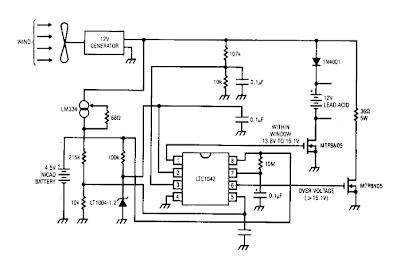
Ultrasonic Dog Whistle
From what Ive read, dogs and other mammals of similar size behave much differently than insects. They tend to respond best to frequencies between 15 and 25 kHz and the older ones are less susceptible to higher tones. This means that an ordinary pest repeller wont work simply because dogs cant hear it. Therefore, I decided to construct a new circuit (based on the venerable 555, of course) with a variable pitch and a relatively loud 82 dB miniature piezo beeper.
The circuit is very simple and can be easily assembled in half an hour. Most of the components are not really critical, but you should keep in mind that other values will probably change the operating frequency. Potentiometer determines the pitch: higher resistance means lower frequency. Since different dogs react to different frequencies, youll probably have to experiment a bit to get the most out of this tiny circuit. The circuit is shown below:
Circuit diagram

Despite the simplicity of the circuit, there is one little thing. The 10nF (.01) capacitor is critical as it, too, determines the frequency. Most ceramic caps are highly unstable and 20% tolerance is not unusual at all. Higher capacitance means lower frequency and vice-versa. For proper alignment and adjustment, an oscilloscope would be necessary. Since I dont have one, I used Winscope. Although its limited to only 22 kHz, thats just enough to see how this circuit works.
There is no need to etch a PCB for this project, perf board will do. Test the circuit to see how it responds at different frequencies. A 4k7 potentiometer in conjunction with a 10nF (or slightly bigger) capacitor gives some 11 to 22kHz, which should do just fine. Install the circuit in a small plastic box and if you want to, you can add a LED pilot light. Power consumption is very small and a 9V battery should last a long time.
Possible further experimentation: Im working on an amplified version of the whistle to get a louder beep. All attempts so far havent been successful as high frequency performance tends to drop dramatically with the 555. Perhaps I could use a frequency doubler circuit - I just dont know and Ive run out of ideas. One other slightly more advanced project could be a simple "anti-bark" device with a sound-triggered (clap) switch that sets off the ultrasonic buzzer as soon as your dog starts to bark.
Administrator has the highest administrative authority
System automatically before each run radio interface unit to connect the RF path calibration, system testing to ensure accuracy. Automated test software is the nerve center of the entire system, it can according to different types of test equipment and RF test instrumentation control switch, complete the testing process, test results and graphs of data saved to the SQLServer database and automatically generate reports. From the functional test automation software can be divided into four parts: system management, online testing, off-line test, view the report. Shown in Figure 3. Automated test software with rights management, into three groups: administrators, testers and visitors. Administrator has the highest administrative authority, to use all the features of the software; testers access times, in addition do not have administrative privileges, other privileges are available; visitors access the lowest, only off-line testing and reporting inquiry. Figure 4 shows the device under test automated testing process. Signals on the GSM, CDMA, DCS, PHS, and 3G bands can be stopped by phone jammer .
First, prompted by the tester to connect the device under test, fill out the necessary test information, and then the user needs to select the test project, either in accordance with the selection of all the test items can also be chosen based on some of the test items. Software testing process will be based on different test items automatically set switches and instrument parameters. After testing, the system prompts the user to save the test results, test results and some of the test pattern stored in the database. Saved to the database for test data, test can be queried at any time, and generate word-type test reports. The base station RF automated test system installed in a large test enclosure, the system run by high-performance workstations, centralized control, test software according to user requirements to complete standard test items for each base station.label model is correct and in line with company requirements; location is correct, no tilt, no more than 5 ° of tilt; phone labels should be in Chinese or symbols, abbreviations represent the following: manufacturer, model, without Commission approval of Certificate No. (CMII), CE mark and the IMEI number (GSM standard), or the corresponding number (other formats).Note 2: You can use room temperature with 5% ± 1% of the way instead of Nacl solution soak salt spray test. DOME with elastic stretch test measured the size of line drawings. endurance test machine with buttons, to exert a certain force (according to design requirements), press the speed of 40-60 beats / minute, press the button (with Dome) 10 million times, the test button after checking the appearance of non-cracking damage and functioning: Dome of the function is normal to pass.
Panic Alarm
The circuit is a sensitive Clap switch with timer action. IC1 is designed as a sensitive inverting amplifier to amplify the sound signals from the condenser mic. Variable resistor VR1 set the sensitivity of mic and resistor R1 and VR2 set the gain of the amplifier. If the sensitivity of mic and amplifier is suitably adjusted, the circuit can detect the sound from a distance of 5meters or more.
 |
| Panic Alarm Circuit Diagram |
When the mic detects clap sound, the ac signals pass through C1and IC1 amplifies the signal. This triggers T1 .When T1 conducts, the trigger pin of the Monostable Timer IC2 will be grounded and the timer triggers. With the given values of R5 and C2, output of IC2 remains high for three minutes. This high output provides power to the ROM IC UM3561.
It generates the Police Siren since its pin6 remains unconnected. Resistor R8 determines the frequency of oscillation of IC3.The siren signals are amplified by T2 and the alarm tone can be heard through the speaker. Zener diode ZD gives 3.1 volt regulated supply to IC3.
Dual Regulated Power Supply
In this circuit, the 7815 regulatates the positive supply, and the 7915 regulates the negative supply. The transformer should have a primary rating of 240/220 volts for europe, or 120 volts for North America.
Dual Regulated Power Supply Circuit diagram :

The centre tapped secondary coil should be rated about 18 volts at 1 amp or higher, allowing for losses in the regulator. An application for this type of circuit would be for a small regulated bench power supply.
Tuesday, December 24, 2013
The list of wholesale cell phone jammer has been prepared
Active set, also known as the active set, and assigned to the mobile stations former frequency to the traffic channel corresponding to the guide. Not in the active set, but has enough strength that the frequency corresponding to the base station with the guide to the business channel can be successfully demodulated pilot collection. Chinas leading communications technology forum 8f "O.Z2t: U% d% G /]! S is not currently activated set and candidate set but it is possible to enter the candidate set of pilot collection in the current system, the CDMA frequency allocation under all possible pilot, in addition to containing frequency in the active set, candidate set and the adjacent pilot focused guide the pilot set to determine the list of messages and a list of Neighborhood Neighborhood Update the parameters PILOT_INC messages. The pilot system bias may is just PILOT_INC of an integer multiple of. The heavy current circuit also includes 220V power supply wire supplying power to cell phone jammer itself.The inspector is checking the content of acceptance standard of cell phone jammer system
The base station to mobile station to send the extended switching indication message EHDM (Extended Handoff Direction Message) or ordinary switch directions message GHDM (General Handoff the Direction Message). mscbsc Mobile Communications Forum has 300,000 communications professionals, more than 50 million copies of GSM/3G and information communication technology, the country O3) the mobile station the pilot included in the active set and switch to the base station to send a message of HCM (Handoff Completion the Message) . , It corresponds to the switch to remove the timer timer started when the pilot strength is lower than T_DROP. When the switch remove the overflow timer expires, the mobile station to the base station to send conduction band strength measurement message. Hold every cell phone and test the effective shielding radius of cell phone jammer from the near to the distant starting from cell phone jammer installation position.
Base station to mobile station to send EHDM or GHDM. Mobile station to the pilot moved to the candidate set, and switch to the base station sends a message of HCM. Pilot home to search for mobile communications, communications engineers, communications personnel, job recruitment, network optimization, traffic engineering, travel accommodation, communications companies blacklist. a variety of conductivity of the above, the base station frequency of collection, respectively, provides for the corresponding search window (PN code phase offset range), mobile search corresponding to the pilot all the available focus on the pilot multipath components in each window. Search window is the active set and candidate set SRCH_WIN_A to determine the search window of the neighbor set is determined by the SRCH_WIN_N SRCH_WIN_R provides for a residual set of search window. These three parameters are included in the paging channel to send the system parameters message. The inspector is checking the content of acceptance standard of cell phone jammer system.
12 volt Cellar Drain Pump
12-volt Cellar Drain Pump Circuit Diagram

Zener Diode Increase Regulator Output Circuit Diagram
Zener Diode Increase Regulator Output Circuit Diagram
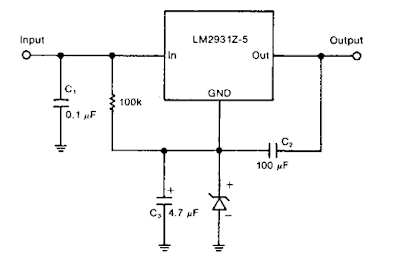
TL594 12V DC Switch Mode Power Supply Rise
3) Able to operate over a variety of input power supply.
4) Able to have over output.
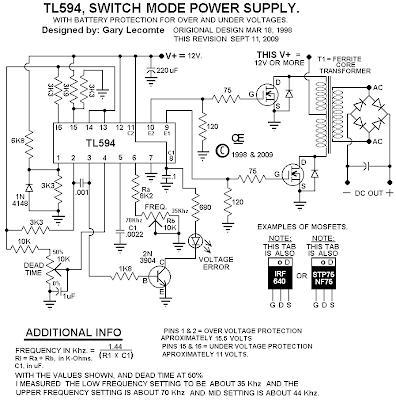
Monday, December 23, 2013
Simple Precision full wave Rectifier Circuit Diagram
Since the outputs of the amplifiers must slew through two diode drops when the input polarity changes, 741 type devices give 5% distortion at about 300 Hz.
Precision full wave Rectifier Circuit Diagram

Four in One Burglar Alarm

Automatic Night Lamp with Morning Alarm
Automatic Night Lamp with Morning Alarm Circuit Diagram

In total darkness, the specified LDR has a resistance in excess of 280 kilo-ohms. When the resistance of LDR1 increases, a short pulse is applied to trigger pin 2 of IC2 via resistor R2 (150 kilo-ohms). This activates the monostable and its output goes high, causing the white LED to glow. Low-value capacitor C2 maintains the monostable for continuous operation, eliminating the timer effect. By increasing the value of C2, the ‘on’ time of the white LED can be adjusted to a predetermined time. LDR2 and associated components generate the morning alarm at dawn. LDR2 detects the ambient light in the room at sunrise and its resistance gradually falls and transistor T1 starts conducting. When T1 conducts, melody-generator IC UM66 (IC3) gets supply voltage from the emitter of T1 and it starts producing the melody. The musical tone generated by IC3 is standard 0-9V transformer. Diodes D1 through D4 rectify the AC voltage and the resulting DC voltage is smoothed by C1. Regulator IC 7806 gives regulated 6V DC to the circuit.
In total darkness, the specified LDR has a resistance in excess of 280 kilo-ohms. When the resistance of LDR1 increases, a short pulse is applied to trigger pin 2 of IC2 via resistor R2 (150 kilo-ohms). This activates the monostable and its output goes high, causing the white LED to glow. Low-value capacitor C2 maintains the monostable for continuous operation, eliminating the timer effect. By increasing the value of C2, the ‘on’ time of the white LED can be adjusted to a predetermined time. LDR2 and associated components generate the morning alarm at dawn. LDR2 detects the ambient light in the room at sunrise and its resistance gradually falls and transistor T1 starts conducting. When T1 conducts, melody-generator IC UM66 (IC3) gets supply voltage from the emitter of T1 and it starts producing the melody. The musical tone generated by IC3 is amplified by single-transistor amplifier T2. Resistor R7 limits the current to IC3 is amplified by single-transistor amplifier T2. Resistor R7 limits the current to IC3 and zener diode ZD limits the voltage to a safer level of 3.3 volts.
The circuit can be easily assembled on a general-purpose PCB. Enclose it in a good-quality plastic case with provisions for LDR and LED. Use a reflective holder for white LED to get a spotlight effect for reading. Place LDRs away from the white LED, preferably on the backside of the case, to avoid unnecessary illumination. The speaker should be small so as to make the gadget compact.
IR Beam Breaker Schematics
This is an Infrared beam breaking alarm ideal to use in entry or passages.It is based on the working of the popular IR sensor Module TSOP 1738 which senses 38 kHz Infrared pulses from the IR LED of the transmitter. Range of the circuit is about 5 meters if the transmitter and receiver are properly aligned TSOP 1738 IR sensor module responds to only 38kHz pulsed infrared rays.
Circuit diagram :

IR Beam Breaker Schematics Circuit Diagram
It will not sense continuous IR ray from the IR LED.So a transmitter circuit(as one in TV remote handset) based on 555 IC is required. Any standard transmitter circuit based on 555 IC can be used. But its output should be 38kHz exactly.TSOP 1738 gives 5 volt output and 5mA current in the off position. That is when IR rays are not available.Its output is current sinking so that when it receives 38kHz IR rays, output becomes zero.Pin 2 of the module should get a supply voltage between 4.5 to 6 volts.Higher voltage above 6 volts will destroy the device. The module is generally immune to ambient light, but may responds to sources of noice such as electronic ballasts.
Out put from the IR module is given to the inverting input of IC1. LM311 is a precision voltage comparator . It looks like the common Op Amps like LM741, CA3130,CA 3140,TL071 etc.But its pin connections and output are different from other Op Amps.
Pin 2 Non inverting
Pin3 Inverting
Pin 1 Ground
Pin8 Vcc
Pin7 Current sinking Output

The non inverting input of IC1 is connected to a potential divider comprising R1 and R2. When the IR sensor gets IR pulses from the transmitter, output of IC1 remains high. When the IR beam breaks, output from the sensor becomes high which triggers IC1. It then sinks current to activate buzzer and LED.
Safety Guard

| Parts | Description |
| R1 | 1M |
| R2 | 470R |
| R3 | 820R |
| R4 | 56K |
| R5 | 470R |
| R6 | 1K |
| R7 | 10K |
| C1 | 1kuF-25V |
| C2 | 100nF-63V |
| C3 | 0.02uF-63V |
| C4 | 10uF-25V |
| C5 | 10uF-25V |
| D1 | 1N4007 |
| D2 | 1N4007 |
| D3 | 1N4007 |
| D4 | 1N4148 |
| D5 | Red LEDs |
| D6 | Red LEDs |
| RL1 | 12V Relay |
| IC1 | AN7809 |
| IC2 | CD4060 |
| SW1 | Switch |
| T1 | 24V-AC Centre Tapped Transformer |
Circuit Operation:
Sunday, December 22, 2013
9V Automatic Battery NiCd Charger
9V Automatic Battery NiCd Charger Circuit Diagram :

Build a Stand by Power Circuit Diagram for Non Volatile Cmos Rams

Running Message Display Schematics Circuit
Light emitting diodes are advantageous due to their smaller size, low current consumption and catchy colours they emit. Here is a running message display circuit wherein the letters formed by LED arrangement light up progressively. Once all the letters of the message have been lit up, the circuit gets reset. The circuit is built around Johnson decade counter CD4017BC (IC2). One of the IC CD4017BE’s features is its provision of ten fully decoded outputs, making the IC ideal for use in a whole range of sequencing operations.In the circuit only one of the outputs remains high and the other outputs switch to high state successively on the arrival of each clock pulse.
Circuit diagram :

Running Message Display Circuit Diagram
The timer NE555 (IC1) is wired as a 1Hz astable multivibrator which clocks the IC2 for sequencing operations. On reset, output pin 3 goes high and drives transistor T7 to ‘on’ state. The output of transistor T7 is connected to letter ‘W’ of the LED word array (all LEDs of letter array are connected in parallel) and thus letter ‘W’ is illuminated. On arrival of first clock pulse, pin 3 goes low and pin 2 goes high. Transistor T6 conducts and letter ‘E’ lights up. The preceding letter ‘W’ also remains lighted because of forward biasing of transistor T7 via diode D21. In a similar fashion, on the arrival of each successive pulse, the other letters of the display are also illuminated and finally the complete word becomes visible. On the following clock pulse, pin 6 goes to logic 1 and resets the circuit, and the sequence repeats itself. The frequency of sequencing operations is controlled with the help of potmeter VR1.
The display can be fixed on a veroboard of suitable size and connected to ground of a common supply (of 6V to 9V) while the anodes of LEDs are to be connected to emitters of transistors T1 through T7 as shown in the circuit. The above circuit is very versatile and can be wired with a large number of LEDs to make an LED fashion jewellery of any design. With two circuits connected in a similar fashion, multiplexing of LEDs can be done to give a moving display effect
Wednesday, June 12, 2013
China mobile GSM phone white display solution
china mobile have many models but hardware have same software different.This picture have a one china mobile phone bored and seven IC;s same IC small and three main IC big and big one UUP IC and second REM thread is power IC.

Electronics Circuit Application
If you china mobile phone create a problem white display.First of all you open a mobile with sample mobile phone tools and put the mobile phone bored same this picture and rehot the UUP IC.Then your china mobile phone problem 100% solve.
If you like my blog and you want to know about the cell phone repairing tips.please give me your comments. Electronics Circuit Application
Digital Keypad Combination Lock Circuit Schematic with explanation
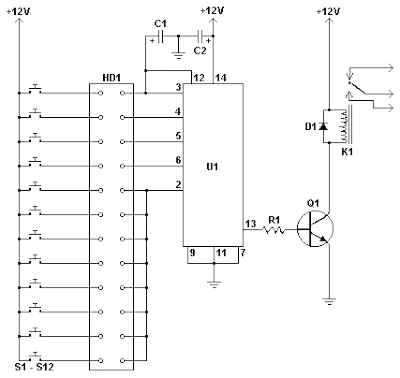
Parts
| |
Notes |
- To set the combination, wire the appropriate switches to U1 pins 3, 4, 5 and 6 using the header. For example if S1 was connected to pin 3, S2 to pin 4, S3 to pin 5 and S4 to pin 6, the combination would be 1,2,3,4. Now wire all other unused switches across the header to pin 2 of U1. In this way you can create any 4 digit combination you want. Pin 2 is the reset pin, so connecting all unused keys to it assures that the entire combination must be reentered if an incorrect key is pressed.
- When the appropriate combination is entered, the relay is activated for a period of time determined by C1. The 1uF capacitor specified in the parts list will result in an on-time of roughly 5 seconds. Increase the value of C1 to increase this time.
- An easy way to make a keypad is to buy 12 PC board mount pushbuttons and then etch a PC board so that the buttons are in 4 rows of 3, similar to a telephone keypad. Place this in a case and then use a label maker or transfer letters to add your numbers to the tops of the pushbuttons. You can also use a pre made keypad but keep in mind that you need a pad which provides an output for each key. Most pads available have the keys connected to provide a row and column signal when they are pressed.
Nokia N91 Phone white display Solution
These problem is same
Nokia n91 blank display .
Nokia n91display problem.
Nokia n91 display jumper.
Nokia n91 no display.
Nokia n91 white display.
You May Like To Read Also!

Electronics Circuit Application
Waterproof Directed Flashlight Ready For Any Objective
Anytime Id personally think about purchasing a brand-new light my personal thoughts introduced me back to a time when us just possessed any Maglite,or even the stock plastic range many of us experienced such as h2o. The actual Fenix Cree LED Flash light changed my thoughts about the approach My partner and i checked out the actual light. Directed highlights will be the tradition nowadays.Most like the Guided spotlights,because they are brighter,and much less cumbersome ultimately.
The potency of the actual Fenix Guided will be the obvious choice for people that should you prefer a brilliant and extremely tough light. This isnt the actual run of the mill flashlight. Wonderfully constructed from airplane rank T-S metal. 630 lumen is an incredible amount of radiance,and also the Fenix is said to be your Best Electric battery Brought Light on Earth!
The thing youll not be worried about,and that is through an massive area of gentle when you select.Which has a column projection associated with 984 Foot. youll be able to deal with a really significant region. Lookup and rescue teams like the Fenix.Income sign expensive unexpected emergency ,sos,and strobe signs,it really is perfect for missions.
An excellent accessory for your own urgent situation tool kit.Traveling out-of-doors inside bad weather isnt any location to do without standard life keeping items. The particular Fenix is additionally Water-proof,consequently absolutely no bother about the actual thunder storms.Stay the flash light up-right along with a reading through light.
The particular protective sprayed accurate wine glass contact lens is very not likely to ever split. Control switches are protected from your elements which has a plastic start. A lanyard along with shoulder strap include the sunshine,as well as Only two additional To Rings to be able to fasten h2o out there.
The particular Cree Directed light is exchangeable and definately will are Fifty,000 hrs. Twice Double a battery packs are all that is required in order to switch on the particular Fenix Directed. The particular Fenix LED Flash light can be vivid and also extraordinary.The quality and also the engineering allow this specific for you to stand out above all various other lighting in its discipline.
A solid perform gentle with spectacular lumen.There is little change continue being mysterious in a thick remember to brush environment. No problem stashing your own Brought torch away.Technology takes on a part while using Fenix also. Knowing how the precise setting you want.Your Fenix Guided flash light requires the anguish from changing the environment any time you hearth up.
Multiple choices learn how to options regulate electric battery consumption.The particular cleverest setting may be the powerful Turbo Function.The producer recommends at most Fifteen minutes at this setting.
In case you direct the stressful existence that requires that you have the greatest lighting effects.In case your straight into research,camping,walking kilometers inside the back-country ,or perhaps fixing the top in Only two am.You need to opt for standing and performance that will keep up.
Regardless of whether your certainly not planning to climb K2 to simply go away the face area on a board.The Fenix Guided flash light goes just about anyplace,and make others signaled simultaneously.Among the most secure alternatives on the marketplace.
The actual best battery pack brightest flashlight on this planet is a pretty remarkable application.Sector level material property,weather conditions immune,and also unexpected emergency flashing allow it to be crucial. Group the Fenix upwards along with be confident youve got every one of the firepower to be in any kind of setting and also control the actual darkness.The particular led light bulbs for home will give you the electricity in order to demand into any kind of scenario.
Wednesday, June 5, 2013
Existing Feeds Vehicle Wiring Products Photo
Automotive Wiring Harness Automotive Wiring Harness For Seating.
Automotive Wiring Harness 2.
Http Www Vehicle Wiring Products E Oto 192175 Jpg.
Ignition Wire Boots China Manufacturer Car Parts Components.
Existing Feeds Http Www Vehicle Wiring Products E Photo Pj2 Jpg.
For Car Wiring Harness For Car Wiring Harness Brand Name Type Model.
Jegs Performance Products 10857 Jegs Premium Automotive Wire.
Car Audio Wire For Sale Buy Cheap Rock Power Car Audio Wire Products.
Automotive Wire Harness The Automotive Harness Is Used In Auto Body.
Http Www Vehicle Wiring Products E Photo T16 Jpg.
Hoppy Trailer Wiring Diagramhoppy Trailer Wiring Diagram
More Information About All New C K Trailer Tow Wiring Diagram Here.
Band Graphic Equalizer Circuit Diagram Design Using Lmc835 Circuit.
Towing Trailer Wiring 7 Pin 7 Waycarend Jpg.
1997 2006 Jeep Wrangler 7 Pin To 4 Pin Adaptor 56019823.
Has A 7 Pin On The Truck It S Wired As Shown Below You Do Need A.
Way Plug Trailer End.
Towing 7 Pin Trailer Wiring.
Trailer Wire Codes Wiring Diagram.
Hoppy 7 Pin Trailer Wiring Diagram Hoppy 7 Pin Trailer Wiring Diagram.
Pin S Type Caravan Wiring Uk Trailer Parts.
Generic Diagram Trailer Wiring
This Allows You To Connect Up The Wiring To Tow A Caravan Or Trailer.
Wiring Colors Http Www Tridenttrailers Com Trailer Wiring Diagram Htm.
Trailer Wiring Diagrams Johnson Trailer Sales Colfax Wisconsin.
Trailer Wiring Diagrams Johnson Trailer Sales Colfax Wisconsin.
Standard Seven Way Plug Wiring Diagram Page 2 Ford Truck.
Heavy Metal Photos Trailer Light Diagram.
Wiring Diagram For Bumper Pull Dump Trailers And Roll Off Dump.
Trailer Pulling Information.
Axle Trailer Axles And Running Gear Components Trailer Plug Wiring.
Generic Diagram Of Trailer Wiring.
